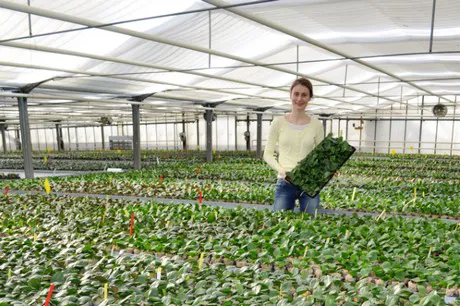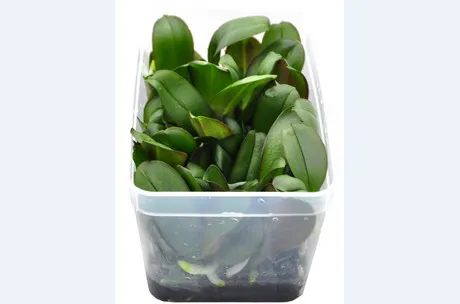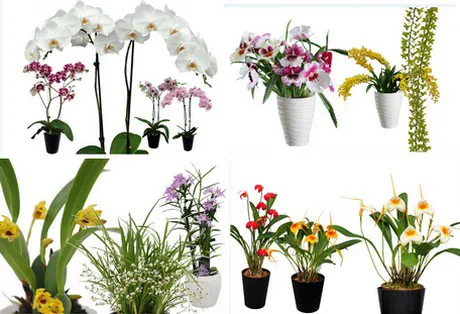
Hassinger Orchideen
Hassinger Orchideen is a German family business that started to focus on ornamentals in the 80s. After a journey through South America and Mexico, the brothers Hans and Roland Hassinger, developed a passion for orchids and started to breed them in the 90s. They recognized a demand for knowledge about breeding and growing orchids and joined a cooperation, named NEON, in 2000. In this cooperation, 6 orchid producers exchange know-how and ideas about orchid production. Since the establishment of NEON, Hassinger Orchideen specialized in breeding and producing of young plants.Breeding, propagation and producing young plants
"We just use our own genetics for all our young plants", says Aline Andreas. At Hassinger Orchideen, the breeding and production of young plants takes place 'in-house' and the propagation of the orchids is done by a third party. So, after breeding a variety, the spikes are brought to a laboratory, called Hark Orchideen, and are multiplied in in-vitro cups. This environment is sterile and ensures clean and healthy plants. Then the young plants are grown by Hassinger Orchideen in a 33,000 square meter greenhouse and are ready to be exported, throughout Europe, which is their main market.
However, when introducing a new variety, it first needs to be tested. "The first testing takes place in Hassingers greenhouse. Then, the best varieties are selected and offered to the customer."
The entire process, from crossing, multiplying, testing and bringing to the market, is executed through Hassinger Orchdeen. According to Aline Andreas, this enables Hassinger Orchideen to offer high quality young plant trays and a transparent and quick handling. "If you purchase varieties from Asian breeders , you will certainly recognize that the plants grow differently in our climate." Therefore, by focusing on the cultivation and adaptation of Hassingers orchids under the European weather conditions, they are able to offer young plants that will grow as expected. "It enables us to deliver a full assortment plus the certainty of better growth.”
Assortment
At the moment, the company breed and produce 300 different orchid varieties. The majority of the assortment consists of Phalaenopsis types; ranging from micro types to large types with flower sizes up to 14 cm. "We can supply them in vitro flask and young plant trays.""As a breeder you need to think forward and you should not be misled by actual trends. Our whole flower market lives from creativity, but adding a new ceramic pot is not inspiring enough." Therefore, Hassinger is developing a new orchid spectrum, next to the Phalaenopsis. "We noticed this increasing demand for special orchids. So, five years ago, we started to ask ourselves what should follow up the Phalaenopsis; we were looking for a descendant."

Upper left: Phaleanopsis. Below right: Bellavallia® arrangement. Upper right and below left: special arrangements.
At the time they started to focus on special orchids, many people advised them to continue breeding Phalaenopsis and to erase the rest because it would not become profitable enough. "We ignored this and look where we are today; the demand for new orchids increased sharply." Especially the Maxillaria, the Encyclia with a fragrance, the Bellavallia® with colors of the sunset and the Dendrochilum with their fragile flower curls are very popular. "We are proud that we kept breeding these orchids at that time. Therefore, we are able to supply them now".
Future plans
Hassinger Orchideen sees a worldwide potential for the Phaleanopsis and is therefore eager to extend their export market. "Europe is still a growing market for us. Therefore, on the short term, we are eager to extend our market with countries like Italy, Poland, and Slovenia", says Aline Andreas. In the long term, they are willing to export to Ukraine and other Non-European countries. "We will keep a close eye on the developments in these countries."In the future, the company will continue to develop new varieties. "Flowers can be seen as fashion items. So, we continuously need to come up with new colors and shapes", says Aline Andreas. Besides that, they are aiming to breed varieties that can be cultivated together in one greenhouse. "This enables growers to offer a broad assortment of products without making large technical adjustments".
The varieties of Hassinger Orchideen are presented at the Flower Trails in Aalsmeer Region, the Netherlands from 09- 12 June, 2015.
For more information
Hassinger Orchideen
Aline Andreas
Email: [email protected]
www.hassinger-orchideen.com
